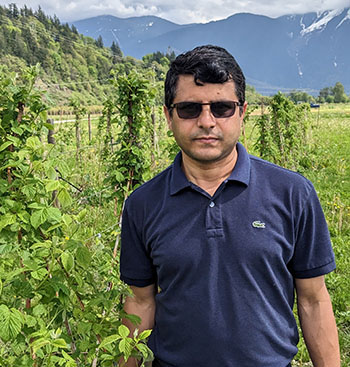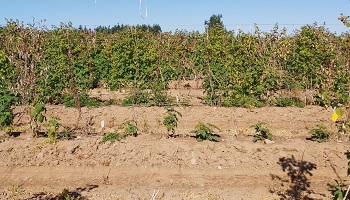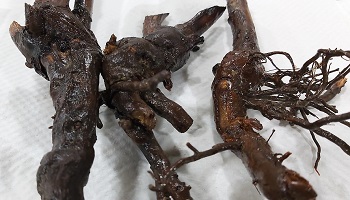For more information
Media Relations
Agriculture and Agri-Food Canada
1-866-345-7972
aafc.mediarelations-relationsmedias.aac@agr.gc.ca
Root rot and wilt (RRW) is a soil-borne disease affecting raspberry plants. Predominately caused by a water mold pathogen, known as Phytophthora, the disease is responsible for reduced crop yields and premature death of the infected plant. The life expectancy of an infected plant can be between five to seven years – half that of a healthy one!
You've likely heard the saying "April showers bring May flowers." April showers can also help bring those pathogenic RRW spores out of dormancy, allowing them to travel through the soil until they can attach to a plant's root tip. The pathogen blocks nutrient and water uptake in the plant, causing dark reddish-brown lesions on the root and crown. As the disease progresses, foliar symptoms, such as scorching, chlorosis and necrosis, and wilting of the plant occur.
Many of the most commonly grown raspberry varieties are susceptible to RRW, making it a serious issue for growers worldwide, including those in British Columbia (B.C.), where almost 80% of Canadian-grown raspberries are produced. Growers currently lack sufficient tools to manage this disease, as the pathogen responsible for causing RRW can remain dormant in the soil for up to 10 years. Fortunately, Agriculture and Agri-Food Canada research scientist Dr. Rishi Burlakoti and his team have stepped up to the plate to investigate this infectious disease and help find sustainable practices and tools to support growers. The project is a collaborative effort with the Lower Mainland Horticultural Improvement Association and researchers from Simon Fraser University and the University of Tennessee.
"Growers are in need of additional tools to combat root rot and wilt in their fields. We now have a better understanding of the disease, which will help in identifying new management practices and the development of disease-resistant varieties."
- Dr. Rishi Burlakoti, Research Scientist, Agriculture and Agri-Food Canada
Identifying the disease-causing pathogen
Dr. Burlakoti's first challenge was to identify the pathogens responsible for causing RRW in B.C.’s major growing areas. To do so, he and his team developed a molecular technique named ‘multiplex targeted sequencing.’ The new technique allowed them to compare 128 individual pathogens, or isolates, recovered from different fields, varieties or infected tissue parts, against known reference sequences of Phytophthora species, Pythium species and Phytopythium using the database from the National Center for Biotechnology Information in Maryland, U.S.
The study found that 85% of the pathogen isolates infecting the commonly grown cultivars, 'Chemainus', 'Rudi' and 'Meeker’, were Phytophthora rubi (P. Rubi). It also uncovered a second species of Phytophthora, called Phytophthora gonapodyides, that made up the remaining 15% of the pathogen isolates found. This new species infected the more moderately susceptible cultivar, known as 'Cascade Bounty’.
Dr. Burlakoti’s new molecular technique can be used to identify the cause of the disease in other impacted regions around the world. The knowledge he gained on the pathogen’s composition in raspberry production regions will also help inform effective strategies to manage this disease.
Screening for RRW and virulence diversity
Breeding disease-resistant raspberry varieties is one of the best options to support growers. This requires reliable screening tools to test plants for potential disease resistance. Dr. Burlakoti and his team trialled a variety of different methods to determine which would produce the most reliable and efficient results, including inoculating pathogens on the root of whole plants, stems of whole plants and detached stems.
Two raspberry cultivars were chosen and inoculated with P. Rubi, as part of the study: 'Chemainus', which is susceptible to RRW, and 'Cascade Bounty', which is moderately resistant to RRW. The plants were then monitored for disease symptoms. Through this study, the team identified five reliable methods that breeding programs can use to evaluate raspberry varieties, germplasm and breeding material for RRW. The tests can also be used to conduct studies on pathogen diversity.
To further support the development of new varieties, Dr. Burlakoti also looked at virulence diversity in P. Rubi. Virulence diversity refers to the ability of the pathogen to cause more or less severe disease to its host. Isolates of P. rubi collected over three years from a variety of raspberry cultivars and fields across B.C.'s Fraser Valley were examined to determine if they would cause higher or lower intensity of the disease in the susceptible cultivar ‘Chemainus’. Virulence diversity was evaluated by monitoring the number of days to first symptom development, wilting progress, root rot index, root regeneration and other root health indicators. While the isolates were found to be quite diverse in causing the disease, more than 75% of the isolates produced severe wilting and root rot symptoms, suggesting that the P. Rubi pathogens in the region were either virulent or highly virulent.
Measuring fungicide sensitivity
Until new disease-resistant raspberry cultivars are available, a grower’s best defense against RRW is fungicides. The fungicide metalaxyl-m, known commercially as ‘Ridomil Gold’, is used widely by Canadian growers to help control Phytophthora pathogen growth in the field; however, not much was known about the pathogen population’s sensitivity to the fungicide.
An examination of P. Rubi isolates for their resistance to metalaxyl-m found that majority of the isolates were sensitive to the fungicide, which is great news for growers. Introducing other management practices will help delay fungicide resistance – something that Dr. Burlakoti plans to investigate further in the next phase of his research.
Key findings and benefits
- Root rot and wilt (RRW) is a soil-borne disease affecting raspberry plants. Predominately caused by a water mold pathogen, known as Phytophthora, the disease can effectively cut the lifespan of infected plants in half, from 10-12 years to five to seven.
- Dr. Rishi Burlakoti and his team identified two species of Phytophthora responsible for causing RRW in major growing areas in B.C.: Phytophthora rubi and Phytophthora gonapodyides. P. rubi is the predominant cause. Continued monitoring of the new species, P. gonapodyides, is required.
- Five effective screening methods were identified that breeding programs can use to evaluate raspberry varieties, germplasm and breeding materials for RRW. The screening methods are also useful for conducting studies on pathogen diversity.
- A study on the virulence diversity of pathogen isolates showed that majority of P. Rubi isolates in the Fraser Valley region of B.C. were either virulent or highly virulent.
- The disease-causing pathogen, P. Rubi, has not yet developed resistance to metalaxyl-m, a widely used fungicide, which is good news for growers.
Photo gallery

Dr. Rishi Burlakoti

A raspberry field infected with root rot and wilt disease.

Samples of a severe root rot infection in a raspberry plant.

A row of raspberry plants show symptoms of severe wilting.